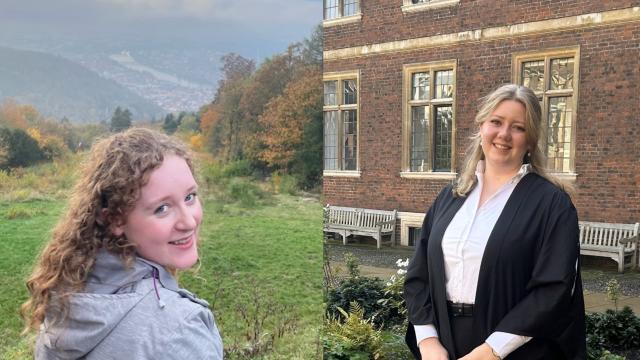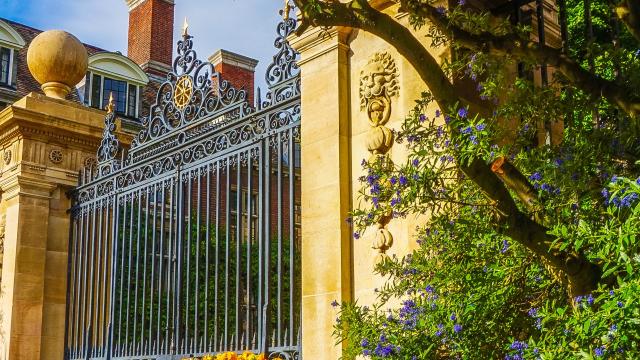
Owned by St Catharine’s since 1626, the Bull building on Trumpington Street briefly became a base for members of the United States (US) military who had enrolled on courses at the University of Cambridge after the end of World War II. The 1955 edition of the St Catharine’s Magazine paid tribute to these soldiers-cum-students:
“Let us not forget these exiled students from a far and friendly land who came to fight a common enemy – and having fought, laid aside their weapons and founded for a brief season an academic home away from home.”
Among them was Richard Barancik, who arrived in Cambridge as a 19-year-old and fresh from serving with the Allied armies’ Monuments, Fine Arts, and Archives (MFAA) programme, otherwise known as ‘The Monuments Men’ for their work seeking out and protecting cultural artifacts from destruction. The Monuments Men were immortalised in a film directed by George Clooney, which was released in 2014, and were honoured with a Congressional Gold Medal the following year.
|
|
|
Now 97 years old and living in Chicago, Richard kindly shared how he came to study at Cambridge and his memories of the Bull building and life in Cambridge in 1946. Read on to find out more about his perspective on this fascinating phase in the history of the College’s Bull building.
Becoming a Monuments Man
Born in Chicago, Richard enlisted in the US Army Enlisted Reserve Corps in 1942 at 17 years old. He recalls that his initial army training included a stint at the University of Nebraska where he studied basic engineering:
“I must confess I was a terrible student in high school. But I spent my time reading and I was always interested in art and drawing. In contrast, my time studying engineering was well-spent because I found something I truly liked and had a natural ability at it. And that’s when I got serious about my studies. Sadly, my time at the University of Nebraska was cut short when we were called to active duty before graduation because, at that time, Hitler was making his final push and the US Army was short of infantry replacements.”
In 1944 Richard was transferred to England with the newly-formed 66th Division, 263rd regiment. On Christmas Eve 1944, he crossed the English Channel to France and the Battle of the Bulge. An accompanying boat, the S.S. Leopoldville, was struck by German torpedoes and over 900 US troops were lost, including members of his battalion. As a result, the surviving members of the 66th Division were diverted to the Saint-Nazaire submarine pens with 200,000 German troops, rather than continuing on to join the Battle of the Bulge.
At the end of the war, Richard was stationed in Austria, where he first became aware of the MFAA. He immediately applied for duty and was given a temporary assignment with the Education, Religion, Fine Arts, and Monuments Office in Salzburg:
“When I arrived in Salzburg, I was not only overwhelmed by the beauty of the town but the quality of the men in the Fine Arts Section. They were typically older and very well educated in the Fine Arts.”
For the next three months, he assisted in the movement of stolen art treasures to the Wiesbaden Central Collecting Point and served as guard at the Austrian salt mines (selected because they were cool, dark and dry) where an estimated 6,500 works of art stolen by the Nazis were stored.
It was during his time with the Monuments Men that Richard learnt about the opportunities for study offered by the US Army’s Training Within Civilian Agencies (TWCA) programme:
“The TWCA offered educational opportunities designed to help soldiers in various professions readjust to civilian life, but getting from Austria to Cambridge wasn’t straightforward. I applied and was accepted and assigned to England to the Royal Institute of Architects who in turn assigned me to the office of Guy Morgan and Partners, where I had my first taste of an architectural firm and worked on the design of the entrance to the MGM movie studio in High Barnet.
“When my assignment was up, Guy Morgan thought it would be a shame to send me back to Army duty. He thought I should continue my studies in architecture at Cambridge, so he took me to meet the Dean of the Cambridge Architecture School who gave me a letter addressed to General Mark Clark, the Commandant of the American Forces in Austria, recommending I be assigned to attend the University of Cambridge’s School of Architecture. And somehow he got a letter from John Winant, the US Ambassador to England, addressed to General Clark also recommending that I be put on duty assigned to Cambridge University Architecture School.”
Life in Cambridge
Sixty of the US service personnel admitted to Cambridge under the auspices of the TWCA programme were accommodated across the different Cambridge Colleges, but the remaining 89 were billeted at the Bull building, which soon became known as ‘Bull College’ (coined by Sir John Sheppard, provost of King’s College). Richard has fond memories of life at Bull College:
“After I received my orders from General Clark to attend Cambridge, I fell into the swing of things. I bought a bicycle, and a hat and gown, and headed to Bull College, which would be my residence. I thought it was quite wonderful. We had to wear our uniforms all the time as we were all still soldiers, and both the American and Union Jack flags hung outside the building.
“It was a most wonderful experience to attend Cambridge at that time. It exposed me to so many marvellous things and brilliant people. The American students, of which I was the youngest, were warmly welcomed by the British students who had just been demobilised. In fact, American students were sort of exotic and we had a busy social life as a result: Sir John Sheppard would have us to tea at King’s on Friday afternoons and Bertrand Russell would have us to tea, also. It was a very heady time.”
Bull College became well known across Cambridge, particularly when its students started distinguishing themselves in sporting competitions. The 1946 Lent Bumps crew were particularly infamous for two reasons: Connie Grayson was the first woman to cox a crew in the race’s history, and the boat smashed into the St Catharine’s boat, which duly sank. Richard recalls rowing with Bull College on another, equally eventful day on the river:
“When we went off, we didn’t realise someone had pulled the plug out from the bottom of the boat and our enthusiasm was quickly dampened. We weren’t great rowers, we were great sinkers! It was hysterically funny.”
By the end of 1945, the British military reclaimed the Bull building for Russian language courses and the TWCA students were given alternative accommodation in barrack-style rooms on Brooklands Avenue – although not for long because the TWCA programme was cancelled in 1947. The Bull building was soon returned to St Catharine’s and it continues to provide student accommodation to this day, as well as meeting spaces and offices for College staff.
Life after Cambridge
Richard reluctantly left Cambridge even after being accepted as a full (non-TWCA) student at the University:
“My father insisted, “Come home now.” He had been advised by his friend General Percy Carroll there was probably going to be a war very soon with Russia. “And also your sister is getting married.” So I went back to Chicago, my sister ended her engagement and we never went to war with Russia.
“My best friend at Cambridge was Bill Howells, a former Spitfire pilot and very bright man, had insisted I take classes from Louis Wirth and William Ogburn at the University of Chicago, which I did. I was so sorry I left Cambridge, but I continued my studies at the University of Chicago as instructed by Bill, before transferring to the University of Illinois Architecture School. My training in England proved most useful: Cambridge made me a more serious architect and more interested in building techniques and materials.
“I went on to form a partnership with a classmate from the University of Illinois, Dick Conte. We were partners at Barancik Conte from 1950 until 1980 when he retired. I continued the firm until 1993 and the last building I designed was the Park Shore on the lakefront in Chicago. Some earlier buildings that I’m particularly proud of are the Barclay Tower in Denver, the Wanamaker House in Philadelphia, and both 1212 and 990 N. Lake Shore Drive in Chicago.”







